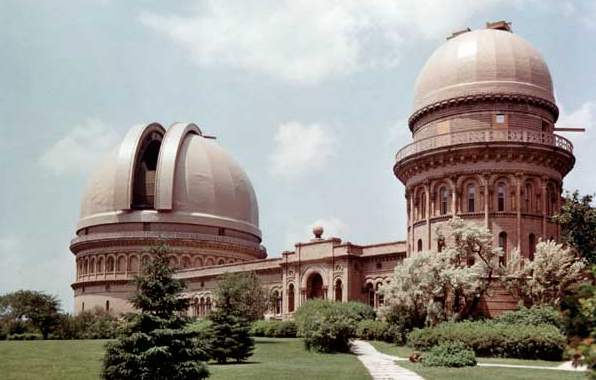Front Page
THE YERKES/WEBB TEAM
The Yerkes Observatory and the Webb Telescope tie-in. The world’s first look at some stunning new images of deep space from the James Webb telescope has ties to the grand observatory located in Williams Bay, Wisconsin. Starting in the early nineteen hundreds, Yerkes Observatory pioneered the way with the first truly astronomical images to be taken. More than one hundred years later NASA was still using that material and the Yerkes technology in its laboratories to develop early prototypes of an infrared telescope.
The Webb telescope is not an optical scope, in spite of the optical ‘representations’ provided to the public of returning photos. Now that Yerkes technology is being used in the new James Webb telescope that orbits around one million miles from Earth. This is the most powerful instrument ever built, to capture distant images, and it is positioned to peer at some of the earliest galaxies and stars ever born. This means looking back into time billions of years ago. The first ‘assembled’ images released from the telescope include some of the most distant galaxies, a giant star nursery, colossal cosmic clouds, and insight into a giant planet beyond our solar system. The Webb telescope is the successor of the famed Hubble telescope which has captured astronomical views for over three decades.
The Webb telescope has the advantage of a gold tinted mirror over two and a half times larger than the Hubble, has the ability to see much fainter objects, and will peer through previously impenetrable clouds of thick cosmic dust. The Webb also spotted an extremely distant population of galaxies whose light has been traveling for billions of years. These new findings and images are from just one small patch of the universe, and it was all made possible because of resources developed over long hard years of real inventive toil at Yerkes Observatory in Williams Bay. The first laser focusing use of specially equipped telescopes was also invented and then developed at the Yerkes. Those telescopic attachments allow telescopes (so equipped) to peer through the atmosphere with the lasers basically penetrating that atmosphere to provide clarity much as if the telescope was mounted up in space instead of on the ground.
Geneva Lake, and the Yerkes Observatory, drew great scientists from all over the world. Even Albert Einstein visited and did some work. The James Webb telescope would not exist in the form it is today and enjoys the success it has already demonstrated, without being thoroughly embedded with the origins of its birth in Williams Bay, Wisconsin. The Yerkes survived intact, after having been summarily abandoned by the University of Chicago, but the Yerkes is not dead yet. It’s been taken over by a foundation dead set on returning it to its former glory. All the supposed limitations that led to the University of Chicago abandoning it have proven to be nothing compared to the intellectual firepower the place can still attract and command.
Greatness has been part of the ‘magnetosphere’ of Yerke’s existence and that mystical, mythical, and ongoing greatness will continue on into the future as the foundation continues to rebuild, rework and refashion the place to once again wear the mantle of success it has deservedly won. Support the Yerkes. Go visit. Go on a tour. Gladly pay for the privilege, especially all those people who live and work around the lake. This land is your land. This observatory is truly yours, along with a good healthy piece of the James Webb telescope.






